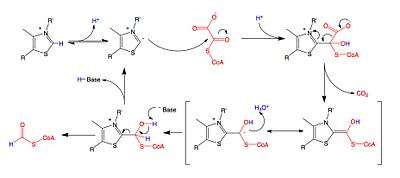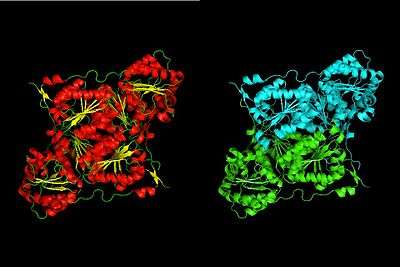Oxalyl-CoA decarboxylase
| oxalyl-CoA decarboxylase | |||||||||
|---|---|---|---|---|---|---|---|---|---|
 | |||||||||
| Identifiers | |||||||||
| EC number | 4.1.1.8 | ||||||||
| CAS number | 9024-96-8 | ||||||||
| Databases | |||||||||
| IntEnz | IntEnz view | ||||||||
| BRENDA | BRENDA entry | ||||||||
| ExPASy | NiceZyme view | ||||||||
| KEGG | KEGG entry | ||||||||
| MetaCyc | metabolic pathway | ||||||||
| PRIAM | profile | ||||||||
| PDB structures | RCSB PDB PDBe PDBsum | ||||||||
| Gene Ontology | AmiGO / EGO | ||||||||
| |||||||||
In enzymology, an oxalyl-CoA decarboxylase (OXC) (EC 4.1.1.8) is an enzyme primarily produced by the gastrointestinal bacterium Oxalobacter formigenes that catalyzes the chemical reaction
- oxalyl-CoA formyl-CoA + CO2
OXC belongs to the family of lyases, specifically the carboxy-lyases (decarboxylases), which cleave carbon-carbon bonds. The systematic name of this enzyme class is oxalyl-CoA carboxy-lyase (formyl-CoA-forming). Other names in common use include oxalyl coenzyme A decarboxylase, and oxalyl-CoA carboxy-lyase. This enzyme participates in glyoxylate and dicarboxylate metabolism. It employs one cofactor, thiamin diphosphate (TPP), and plays a key role in catabolism of oxalate, a highly toxic compound that is a product of the oxidation of carbohydrates in many bacteria and plants.[1] Oxalyl-CoA decarboxylase is extremely important for the elimination of ingested oxalates found in human foodstuffs like coffee, tea, and chocolate,[2] and the ingestion of such foods in the absence of Oxalobacter formigenes in the gut can result in kidney disease or even death as a result of oxalate poisoning.[3]
Evolution
Oxalyl-CoA decarboxylase is hypothesized to be evolutionarily related to acetolactate synthase, a TPP-dependent enzyme responsible for the biosynthesis of branched chain amino acids in certain organisms.[4] Sequence alignments between the two enzymes support this claim, as do the presence of vestigial FAD-binding pockets that play no role in either enzyme’s catalytic activity.[5] The binding of FAD at this site in acetolactate synthase and the binding of ADP at a cognate site in OXC are thought to play roles in the stabilization of the tertiary structures of the proteins.[6] No FAD binding is observed in oxalyl-CoA decarboxylase,[7] but an excess of coenzyme A in the crystal structure has led to the hypothesis that the binding site was co-opted during OXC evolution to bind the CoA moiety of its substrate.[8] Despite their similarities, only oxalyl-CoA decarboxylase is necessary for the formation of ATP in Oxalobacter formigenes, and exogenous ADP has been demonstrated to increase the decarboxylase activity of OXC, but not acetolactate synthase.[9][10]
Reaction Mechanism

A key feature of the cofactor TPP is the relatively acidic proton bound to the carbon atom between the nitrogen and sulfur in the thiazole ring, which has a pKa near 10.[11] This carbon center ionizes to form a carbanion, which adds to the carbonyl group of oxalyl-CoA. This addition is followed by the decarboxylation of oxalyl-CoA, and then the oxidation and removal of formyl-CoA to regenerate the carbanion form of TPP. While the reaction mechanism is shared with other TPP-dependent enzymes, the residues found in the active site of OXC are unique, which has raised questions about whether TDP must be deprotonated by a basic amino acid at a second site away from the carbanion-forming site to activate the cofactor.[12]
Structure

Oxalyl-CoA decarboxylase is tetrameric, and each monomer consists of three α/β-type domains.[13] The thiamine diphosphate-binding site rests on the subunit-subunit interface between two of the domains, which is commonly seen in its class of enzymes. Oxalyl-CoA decarboxylase is structurally homologous to acetolactate synthase found in plants and other microorganisms, but OXC binds ADP in a region that is similar to the FAD-binding site in acetolactate synthase.[14][15]
As of late 2007, 6 structures have been solved for this class of enzymes, with PDB accession codes 2C31, 2JI6, 2JI7, 2JI8, 2JI9, and 2JIB.
See also
References
- ↑ Baetz, A.L. and Allison, M.J. “Purification and characterization of formyl-coenzyme A transferase from Oxalobacter formigenes.” J. Bacteriol 172, 7 (1990).
- ↑ Gasinka, A. and Gajewska, D. “Tea and Coffee as the Main Source of Oxalate in Diets of Patients with Kidney Oxalate Stones.” Roczn. Pzh 58, 1 (2007).
- ↑ Turoni, S. et al. “Oxalate-degrading activity in Bifidobacterium animalis subsp. lactis: impact of acidic conditions on the transcriptional levels of the oxalyl coenzyme A (CoA) decarboxylase and formyl-CoA transferase genes.” Appl. Environ. Microbiol. 76, 10 (2010).
- ↑ Dailey, F.E and Cronan, J.E. “Acetohydroxy acid synthase I, a required enzyme for isoleucine and valine biosynthesis in Escherichia coli K-12 during growth on acetate as the sole carbon source." J. Bacteriol 165, 2 (1986).
- ↑ Chipman, D. et al. “Biosynthesis of 2-aceto-2-hydroxy acids: acetolactate synthases and acetohydroxyacid synthases.” Biochimica et Biophysica Acta (BBA) - Protein Structure and Molecular Enzymology 1385, 2 (1998).
- ↑ Signh, B.K. and Schmitt, G.K. “Flavin adenine dinucleotide causes oligomerization of acetohydroxyacid synthase from black Mexican sweet corn cells.” FEBS Letters 258, 1 (1989).”
- ↑ Svedruzic, D. et al. “The enzymes of oxalate metabolism: unexpected structures and mechanisms.” Archives of Biochemistry and Biophysics 433, 1 (2005).
- ↑ Berthold, C.L. et al. “Crystallographic Snapshots of Oxalyl-CoA Decarboxylase Give Insights into Catalysis by Nonoxidative ThDP-Dependent Decarboxylases.” Structure 15, 7 (2007).
- ↑ Maestri, O. and Joset, F. “Regulation by external pH and stationary growth phase of the acetolactate synthase from Synechocystis PCC6803.” Mol.Microbiol. 37, 4 (2000).
- ↑ Whitlow, K.J. and Polgase, W.J. “Regulation of acetohydroxy acid synthase in streptomycin-dependent Escherichia coli.” J. Bacteriol 121, 1 (1970).
- ↑ Berg, J.M, Tymoczko J.L., and Stryer, L. Biochemistry: 6th Edition. NY: W.H. Freeman and Company. Page 479.
- ↑ Berthold C.L. et al. “Structural basis for activation of the thiamin diphosphate-dependent enzyme oxalyl-CoA decarboxylase by adenosine diphosphate.” J. Biol. Chem. 280, 50 (2005).
- ↑ Werther, T. et al. “New insights into structure–function relationships of oxalyl CoA decarboxylase from Escherichia coli.” FEBS Journal 277, 12 (2010).
- ↑ Dugglebay, R.J. and Pang, S.S. “Acetohydroxyacid Synthase.” Journal of Biochemistry and Molecular Biology 33, 1 (2000).
- ↑ Azcarate-Peril, M.A. et al. “Transcriptional and Functional Analysis of Oxalyl-Coenzyme A (CoA) Decarboxylase and Formyl-CoA Transferase Genes fromLactobacillus acidophilus.” Appl. Environ. Microbiol. 72, 3 (2006).